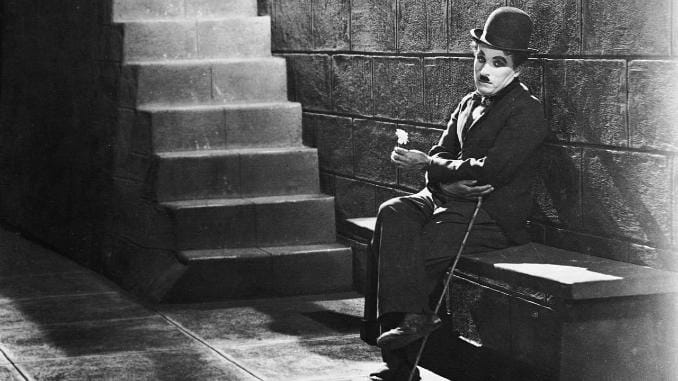The Real Charlie Chaplin Tries to Separate the Man from the Tramp

“The misery that is upon us is but the passing of greed, the bitterness of men who fear the way of human progress. The hate of men will pass, and dictators die, and the power they took from the people will return to the people. And so long as men die, liberty will never perish.”
Encapsulating a man like Charlie Chaplin, who was born in a slum, orphaned at a young age, ground through the same kind of workhouse that Dickens railed against before going on to become the most famous actor in human history before his 30th birthday, is a seemingly impossible task. Chaplin’s work bridges the 19th and 20th centuries, and is really the missing link between live theater and film. He was fiercely, angrily populist in his politics, such that he became an enemy of America’s vicious authoritarians during the reign of McCarthy and Hoover, and spent much of his autumn years in exile from the States.
Peter Middleton and James Spinney’s documentary, The Real Charlie Chaplin, attempts to reckon with all of this—and with Chaplin’s well-documented abuse allegations and controversies—through a kind of deconstruction. It starts by forcibly splitting Charlie Chaplin the man from Charlie Chaplin the character, then mining oral history and the historical record to fill the space that exists in the midst of that dichotomy.

The documentary makes use of several audio interviews with people who knew Chaplin, often dramatizing the interviews with actors lip-synching along to the voices as the interview unfolds. Though great care was taken in the staging of these sequences, which are many times framed as if they are being captured by a documentary film crew, their artificiality can sometimes butt heads with the rest of the film. That largely consists of footage of Chaplin’s work and newsreels from the world in which he lived, and these are the parts where The Real Charlie Chaplin does an admirable job of trying to put the viewer in the mindset of the Gilded Age that gave rise to the performer.
The documentary picks one woman, who knew Chaplin from a young age, to serve as a sort of framing device, setting up the humble beginnings of the boy who would become the world’s most famous and recognized actor, and then circles back with her to hear recollections of meeting him again decades later. The film’s narrator (Pearl Mackie), meanwhile, draws an immediate distinction between this real man and his character, “The Tramp,” which was itself a callback to the old vaudeville archetype.
The movie traces the origins of both Chaplin and the role from which his body of work is inextricable, and puts movies like The Kid (about an abandoned youth) and The Gold Rush in context with the man’s life. I went into the movie knowing little about its scope, and after a solid hour of fastidious historical positioning, of interviews with the manager of the comedy troupe where he first got his start and old video of his rapturous reception by audiences around the world, I was worried it was not going to go where any movie titled The Real Charlie Chaplin has to.

All of Chaplin’s genius and compassion, controversy and craft, must be viewed in context with the man’s personal life. Almost every one of his four marriages began with relationships with underage girls—an aspect of his personal life that was aired again when his second wife published a tell-all book, but seems as if it’s largely been forgotten thanks to efforts in the late ’80s and early ’90s to rehabilitate the man’s legacy. 1992’s Oscar-nominated Chaplin, starring Robert Downey, Jr., included those parts of Chaplin’s history, but gave them short shrift. Thirty years on from that film, it stands as the last word on Chaplin from filmmakers who were his contemporaries, and ends in a scene where long excerpts of his film career are aired as old Chaplin drinks in the laughter of a modern-day audience.
In her excellent Lolita Podcast, Paste contributor Jamie Loftus dedicates a portion of her deep dive to Chaplin, and how his own abuses are now barely remembered in many assessments of the man. A great example of a remembrance of Chaplin’s work that didn’t mention his complicated legacy was the one I wrote when I focused on The Great Dictator. The tramp, it seems, often eclipses the man.
-

-

-

-

-

-

-

-

-

-

-

-

-

-

-

-

-

-

-

-

-

-

-

-

-

-

-

-

-

-

-

-

-

-

-

-

-

-

-

-









































